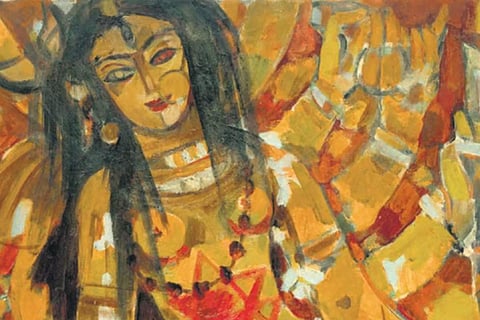
- LIFESTYLE
- FASHION
- FOOD
- ENTERTAINMENT
- EVENTS
- CULTURE
- VIDEOS
- WEB STORIES
- GALLERIES
- GADGETS
- CAR & BIKE
- SOCIETY
- TRAVEL
- NORTH EAST
- INDULGE CONNECT

Kali is a goddess of the harsher truths. Variously associated with time, change, creation, power, destruction and death, she is, at once, a protective mother and a furious head-reaper, a nurturer and a destroyer. Worshipped throughout South Asia, and particularly in Nepal, southern India, Bengal and Assam, the four-armed and dark-skinned deity, who has a garland of demon heads adorning her neck and blood dripping off her long tongue, is also a goddess of the margins. Her non-Vedic origins have made her a symbol of indigenous assertion for the lower caste and tribal communities, while her embodiment of female power and agency has dubbed her a feminist icon. ‘Kali- Reverence & Rebellion’, an ongoing exhibition of artworks based on the goddess at DAG, Delhi, explores these interpretations by presenting how she has featured in the artistic imagination as well as popular culture in India over the years.
Curated by Gayatri Sinha, the exhibition displays works done in a range of media, including paintings, posters, figurines and sculptures, from across different periods and regions in the country. “The exhibition presents a pan-Indian narrative of the ancient deity. It showcases the different aspects of her mythology from across India, and also how different groups such as devotees, academicians, nationalists, tribal communities and marginalised and social collectives have perceived and co-opted her iconography,” says Ashish Anand, CEO and MD of DAG.
Kali, Three Ways
Grouped under the three categories of ‘Divinity’, ‘Subalternity’ and ‘Protest’, the paintings, from unknown artists of the Kalighat School of art and British chroniclers of the colonial times to the ones by contemporary artists in the 2000s, trace how the image of the deity has transformed over centuries with the changing cultural, spiritual and aesthetic landscape. The early paintings and prints, including commissioned works, depict her in the context of the mythology associated with her based on works such as the Mahabhagavata Purana. They reflect the “dark, powerful and untameable aspects of feminine worship in the Indian subcontinent”. While for artists in the modern era, with Nirode Mazumdar and M F Husain, Kali is neither Puranic nor Tantric. Severed from her textual and popular representations, she is completely remade in the imaginations of these artists, variously represented in abstract and cubist styles of painting, among others.
The exhibition also presents how the imagery of Kali was invoked as a call to rebellion during various points in the Independence movement against the British, who vilified her as a goddess of the “thugees”. A 20th century poster on display, with the inscription ‘Jai Hind’, shows Subhash Chandra Bose presenting his own head in one hand while wielding a sword in the other, visually encapsulating his famous words ‘Give me your blood, and I’ll give you freedom’. “In the Devi Bhagavat Purana, Kali’s fierce resistance and battle with the asuras may have identified her as an invincible goddess, who was invoked during the struggle against the British imperial presence,” says Sinha.
The Bengali Kali
A majority of the works on display are from Bengal where the deity holds an unparalleled appeal in both the religious and popular imaginations, with her iconography spread across the land, from calendars to matchbox covers. “Kali has appealed to different kinds of communities under different political and social compulsions. These had included the demand to be incorporated in the broad Hindu fold, the nationalist struggle against the proposed division of Bengal in 1905 and even the advertising of goods, especially in Bengal. Kali also served as a mascot during farmers’ and labourers’ protest movements at different points in the 20th century,” Sinha says.
Kali’s “dark skin, open and wild hair, flagrant rejection of purity and pollution, and her association with blood and death” also gives her a “rootedness” and “accessibility”, which upholds her position as a deity of the underprivileged and the marginalised. Through a mix of sculptural and popular artworks, the exhibition also looks at how Kali emerges as an “omnipresent cultural and social force despite her location within the margins”.
The secularist appeal
Talking about the secular appeal of the deity, Sinha says: “During our research, we found that in some sites dedicated to Kali there were Muslim Sufi saints such as Sadan Shah at the Kali temple in Pavagadh, and a mazaar for Sayyid Baba in the Kali temple in Etawah. Furthermore, Kazi Nasrul Islam, who is claimed by both India and Bangladesh as their poet, also dedicated poems of great reverence to Kali.” Sinha believes that even in contemporary India, Kali’s position continues to be what it was, “as a household goddess among some devotees who see her as a divine, protective mother, as a figure who protects the disenfranchised, as seen in theatre such as Mudiyetu and Theyyam performances and as a support to women under duress”.